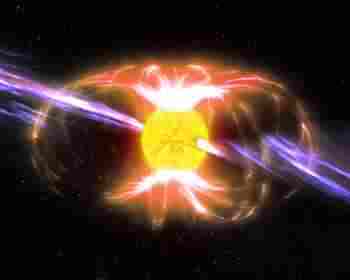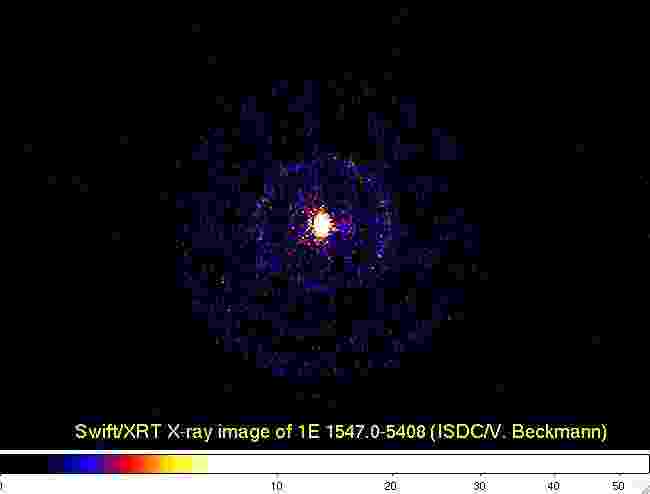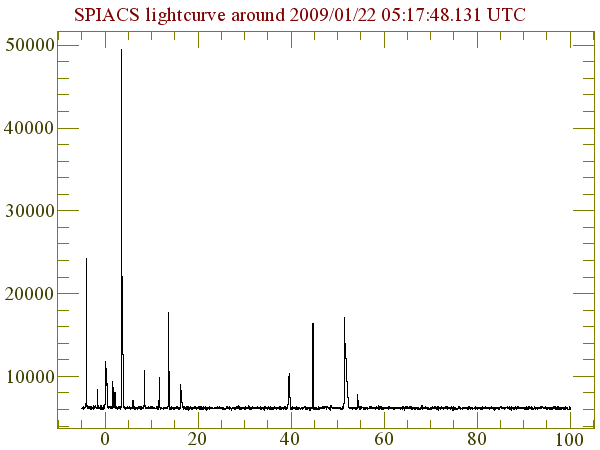 Link zur deutschen Version
dieser Seite
Link zur deutschen Version
dieser Seite INTEGRAL observes intense activity of a neutron star
 Link zur deutschen Version
dieser Seite
Link zur deutschen Version
dieser Seite ![]() Versione Italiana
Versione Italiana
The ISDC has asked ESA to point the INTEGRAL satellite now towards this
enigmatic object, and INTEGRAL started with a dedicated
observation on Saturday, January 24. The data of this observation are immediately
publicly available for analysis. Through the analysis of the data
we hope to learn more about the physical processes which are
responsible for these elusive events. A quick analysis of the data
shows that the magnetar is indeed still in an active phase, with
several bright bursts caught by the main instrument IBIS/ISGRI (see a
short report of Baldovin et al. 2009, Astronomer's Telegram
1908). Apart from bursts, which occurred during the observation
and were again seen by several satellites, it was also possible to
determine the X-ray spectrum of this AXP. The spectrum extends up to
energies of at least 150 keV and has the signature of processes
usually associated with emission of non-thermal
origin, rather than showing a "hot spot" on the neutron star's
surface. In addition
we have informed the astrophysical community about the
events seen by INTEGRAL in two GCN notes by Volodymyr Savchenko of the ISDC
(GCN 8837) and by
Sandro Mereghetti (IASF/Milano, GCN 8841).
In case of questions and comments: contact me at the APC. Last update: January 27, 2009
 On January 22, 2009, the anti-coincidence system (ACS), a massive ring
of gamma-ray detectors on-board ESA's INTEGRAL
satellite, detected about 200 intense flashes of gamma-ray light,
lasting from 0.1 to 8 seconds in duration.
The events were among the
brightest ever seen in ACS since INTEGRAL's launch in October 2002, much brighter than the usual gamma-ray burst. On a normal day, INTEGRAL detects between none and a few faint
events in ACS. As also NASA's Swift
satellite and the
Fermi
satellite had seen some of the bright flares (GCN 8833, GCN 8835), it became clear that
these outbursts are indeed due to the astrophysical source 1E
1547.0-5408, a so-called
anomalous X-ray pulsar in the Norma spiral arm of our galaxy. These stars, which are about 25 kilometers in
diameter but are more massive than the sun, are believed to have
extremely strong magnetic fields, about 1015 times stronger
than the magnetic field of the Earth. The outbursts are thought to be
connected to these magnetic fields - perhaps reconnection of the
magnetic field lines due to a breaking of the neutron star's outer crust.
On January 22, 2009, the anti-coincidence system (ACS), a massive ring
of gamma-ray detectors on-board ESA's INTEGRAL
satellite, detected about 200 intense flashes of gamma-ray light,
lasting from 0.1 to 8 seconds in duration.
The events were among the
brightest ever seen in ACS since INTEGRAL's launch in October 2002, much brighter than the usual gamma-ray burst. On a normal day, INTEGRAL detects between none and a few faint
events in ACS. As also NASA's Swift
satellite and the
Fermi
satellite had seen some of the bright flares (GCN 8833, GCN 8835), it became clear that
these outbursts are indeed due to the astrophysical source 1E
1547.0-5408, a so-called
anomalous X-ray pulsar in the Norma spiral arm of our galaxy. These stars, which are about 25 kilometers in
diameter but are more massive than the sun, are believed to have
extremely strong magnetic fields, about 1015 times stronger
than the magnetic field of the Earth. The outbursts are thought to be
connected to these magnetic fields - perhaps reconnection of the
magnetic field lines due to a breaking of the neutron star's outer crust. A short observation of the Swift satellite shows rings around the star
in the X-rays (see image on the left). These are caused by dust in between the star and
us, as pointed out by A. Tiengo (GCN 8848). The dust scatters the X-ray light - a similar effect as one
sometimes sees on Earth as halos around the Sun or Moon.
A short observation of the Swift satellite shows rings around the star
in the X-rays (see image on the left). These are caused by dust in between the star and
us, as pointed out by A. Tiengo (GCN 8848). The dust scatters the X-ray light - a similar effect as one
sometimes sees on Earth as halos around the Sun or Moon. The
image on top of this page is an artist's impressions of an anomalous X-ray
pulsar (Credit: John Rowe Animations). The light curve on the bottom shows
15 of the 200 outbursts seen from 1E
1547.0-5408 by the ACS. All the bright ACS events can be found here
The
image on top of this page is an artist's impressions of an anomalous X-ray
pulsar (Credit: John Rowe Animations). The light curve on the bottom shows
15 of the 200 outbursts seen from 1E
1547.0-5408 by the ACS. All the bright ACS events can be found here